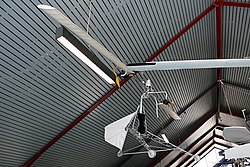Nagler-Rolz NR 54
| Nagler-Rolz NR 54 | |
|---|---|
 Nagler-Rolz NR 54 in the helicopter museum in Bückeburg |
|
| Type: | Test helicopter |
| Design country: | |
| Manufacturer: |
Nagler-Rolz aircraft construction |
| Production time: |
1942 |
| Number of pieces: |
4 prototypes |
The Nagler-Rolz NR 54 was the first foldable and portable mini helicopter in Germany. The two Argus motors on the rotor blades drove small propellers (diameter 58 cm), the thrust of which set the rotor turning. There was no torque compensation z. B. necessary by a tail rotor. Four devices were built and tested.
history
The Austrian Bruno Nagler initially worked on gyroscopes as an employee of Raoul Hafner in England. In 1935 he returned to Austria and teamed up with Franz Rolz to develop ultra-light helicopters. To this end, they founded the Nagler-Rolz-Flugzeugbau company with workshops near Vienna . The work led to success in the first years of the war. Two single-seat miniature helicopters, NR 54 (1941) and NR 55 (1940), were developed, but only the most recently completed NR 54 actually carried out free flights.
construction
The NR 54 basically consisted of a three-legged frame with a rotating wing attached above. The first version V1 had a single-blade rotor 3965 mm long. At the other end there was a counterweight of a 24 HP motor that drove two propellers rotating in opposite directions, which were attached to the rotor blade at a distance of 3 m from the axis of rotation. However, this arrangement did not prove to be advantageous and the device did not fly. Since the empty weight was 80 kg, the device was also considered to be too heavy for a "backpack helicopter", and the fuel supply caused difficulties because the engine and carburetor were arranged separately.
In the V2, the single-blade rotor was replaced by a normal two-blade rotor with a diameter of 7.92 m. An 8 HP Argus motor with a propeller was attached to each rotor blade at a distance of 1.5 m from the axis of rotation. This reduced the usable length of the 30 cm deep rotor blades to 2.50 m each. However, this arrangement worked; with a permitted take-off weight of 140 kg, the device weighed only 36.5 kg when empty. The rate of descent should remain below 4.8 m / s in autorotation and below 1.2 m / s in the event of a motor failure.
Technical specifications
| Parameter | Nagler-Rolz NR 54 V2 |
|---|---|
| length | 2.42 m |
| Rotor diameter | 7.92 m |
| Empty mass | 36.5 kg |
| Takeoff mass | 140 kg |
| drive | 2 × Argus ZF140 with 5.9 kW (8 PS) each |
| Top speed | 80 km / h |
| Range | 50 km |
| Summit height | 457 m |
| crew | 1 |
literature
- Heinz J. Nowarra : The German Air Armament 1933–1945, Volume 2, Bernard & Graefe Verlag, ISBN 3-7637-5468-7 .
- Peter W. Cohausz: German planes until 1945, Aviatic Verlag, ISBN 978-3-942645-00-3 .
Web links
- Nagler-Rolz NR 54 in the helicopter museum in Bückeburg
- Color photo and technical data as well as historical information
- Photos and technical data
Individual evidence
- ↑ Source: Bückeburg Helicopter Museum
- ↑ a b Kyrill von Gersdorff, Kurt Knobling: Helicopter and Gyrocopter - Die deutsche Luftfahrt Vol. 3 , Bernard & Graefe Verlag Munich, 1982, p. 71
- ^ Heinz J. Nowarra, Die deutsche Luftrüstung 1933–1945, Volume 4, Bernard & Graefe Verlag, ISBN 3-7637-5468-7